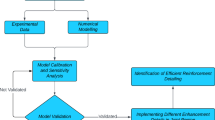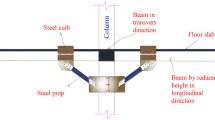Abstract
This study investigates the performance of new composite (steel-concrete) moment connections through numerical simulations. The innovative aspects of this research lay in the use of end-plate connections between steel beams and concrete-filled tube (CFT) columns that utilize a combination of low-carbon steel and shape memory alloy (SMA) components. In these new connections, the intent is to use the recentering effect provided by super-elastic SMA tension bars to reduce the level of building damage and residual drift after a major earthquake. The low-carbon steel components provide excellent energy dissipation. The analysis and design of these structures is complicated because the connections cannot be modeled as being simply pins or full fixity ones; they are partial restraint (PR). A refined finite element (FE) model with sophisticated three dimensional (3D) solid elements was developed to perform numerical experiments on the PR-CFT joints with a view to obtaining the global behavior of the connection. Based on the behavioral information obtained from these FE tests, simplified connection models were formulated using 2D joint elements with nonlinear spring components. The behavior of entire connections under cyclic loads was examined. The results were compared with the connection behavior obtained from the 3D FE simulations and corresponding connection tests. Good agreement was found between the simple and sophisticated models, confirming the robustness of the approach.
Similar content being viewed by others
References
ABAQUS (2006). ABAQUS Theory and user’s manual. Version 6.6-1. Hibbit Karlsson & Sorensen Inc., Pawtucket, RI.
AISC (2001). Manual of steel construction: Load and Resistance Factor Design (LRFD). 3 rd Ed. American Institute of Steel Construction, Chicago, IL, USA.
AISC (2005) Prequalified Connections for Special and Intermediate Steel Moment Frames for Seismic Applications (ANSI/AISC 358-05). American Institute of Steel Construction, Chicago, IL, USA.
Astaneh-Asl, A. (1995). Seismic design of bolted steel moment-resisting frames. Steel tips, Structural Steel Educational Council, Technical Informational & Product Service, USA.
Fugazza, D. (2003). Shape alloy devices in earthquake engineering: mechanical properties, constitutive modeling and numerical simulations. Master’s Thesis, Rose School, Italy.
Green, T. P., Leon, R. T., and Rassati, G. A. (2004). “Bidirectional tests on partially restrained, composite beam-column connections.” ASCE Journal of Structural Engineering, 130(2), pp. 320–327.
Hu, J. W. (2008). Seismic performance evaluations and analyses for composite moment frames with smart SMA PR-CFT connections. Ph.D. Dissertation, Georgia Institute of Technology, Atlanta, GA, USA.
Hu, J. W., Choi, E., and Leon, R. T. (2011). “Design, analysis, and application of innovative composite PR connections between steel beams and CFT columns.” Smart Materials and Structures, 20(2), DOI 10.1088/0964-1726/20/2/025019.
Hu, J. W., Kang, Y. S., Choi, D. H., and Park, T. (2010). “Seismic design, performance, and behavior of composite-moment frames with steel beam-to-concrete filled tube column connections.” International Journal of Steel Structures, 10(2), pp. 177–191.
Leon, R. T. (1997). Seismic performance of bolted and riveted connections. Background reports: metallugy, fracture mechanics, welding, moment connections, and frame system behavior. FEMA publication No.288, Federal Emergency Management Association (FEMA), Washington, DC, USA.
Leon, R. T. and Hu, J. W. (2007). “Composite joint designmigration from finite element models to component models.” Proc. 5 th International Conference on Advanced in Steel Structure, Singapore.
Leon, R. T. and Hu, J. W. (2008). “Design of innovative SMA PR connections between steel beams and composite columns.” Proc. International Workshop on Connections in Steel Structures, Connections VI.
Mazzoni, S., Mckenna, F., and Fenves. G. L. (2006). OpenSEES command language manual v. 1.7.3. Department of Civil Environmental Engineering, University of California, Berkley, CA, USA.
Ocel, J. M., DesRoches, R., Leon, R. T., Hess, W. G., Krumme, R., Hayes, J. R., and Sweeney, S. (2004). “Steel beam-column connections using shape memory alloys.” ASCE Journal of Structural Engineering, 130(5), pp. 732–740.
Park, T., Hwang, W. S., Leon, R. T., and Hu, J. W. (2011). “Damage evaluation of composite-special moment frames with concrete-filled tube columns under strong seismic loads.” KSCE Journal of Civil Engineering, 15(8), pp. 1381–1394.
Penar, B. W. (2005). Recentering beam-column connections using shape memory alloys. Master’s Thesis, Georgia Institute of Technology, Atlanta, GA, USA.
Rassati, G. A., Leon, R. T., and Noe, S. (2004). “Component modeling of partially restrained composite joints under cyclic and dynamic loading.” ASCE Journal of Structural Engineering, 130(2), pp. 343–351.
Speicher, M., DesRoches, R., and Leon, R. T. (2011). “Experimental results of NiTi shape memory alloy (SMA)-based beam-column connection.” Engineering Structures, 33(9), pp. 2448–2457.
Swanson, J. A. and Leon, R. T. (2000). “Bolted steel connections: Tests on T-stub components.” ASCE Journal of Structural Engineering, 126(1), pp. 50–56.
Swanson, J. A. and Leon, R. T. (2001). “Stiffness modeling of bolted T-stub connection components.” ASCE Journal of Structural Engineering, 127(5), pp. 498–505.
Tsai, K. C., Weng, Y. T., Lin, M. L., Chen, C. H., Lai, J. W., and Hsiao, P. C. (2004). “Pseudo dynamic tests of a fullscale CFT/BRB composite frame.” ASCE Proceedings of the 2004 Structure Congress.
Wu, L. Y., Chung, L. L., Tsai, S. F., Lu, C. F., and Huang, G. L. (2005). “Seismic behavior of bolted beam to column connections for concrete filled steel tube.” Journal of Constructional Steel Research, 61(10), pp. 1387–1410.
Wu, L. Y., Chung, L. L., Tsai, S. F., Lu, C. F., and Huang, G. L. (2007). “Seismic behavior of bidirectional bolted connections for CFT columns and H-beams.” Engineering Structures, 29(3), pp. 395–407.
Author information
Authors and Affiliations
Corresponding author
Additional information
Note.-Discussion open until August 1, 2013. This manuscript for this paper was submitted for review and possible publication on June 29, 2012; approved on February 19, 2013.
Rights and permissions
About this article
Cite this article
Hu, JW., Hwang, WS. Design and behavior of recentering beam-to-CFT column connections with super-elastic shape memory alloy fasteners. Int J Steel Struct 13, 55–69 (2013). https://doi.org/10.1007/s13296-013-1006-9
Published:
Issue Date:
DOI: https://doi.org/10.1007/s13296-013-1006-9




